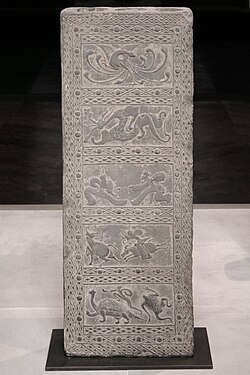Astronomy:Four Symbols (China)
The Four Symbols (Chinese: 四象; pinyin: Sì Xiàng, literally meaning "four images") are four mythological creatures in the Chinese constellations. They are the Azure Dragon of the East, the Vermilion Bird of the South, the White Tiger of the West, and the Black Turtle of the North. Each one of them represents a direction and a season, and each has its own individual characteristics and origins. Symbolically and as part of spiritual and religious belief, they have been culturally important across China and East Asia.
History
The Four Symbols were given human names[clarification needed] after Daoism became popular. The Azure Dragon has the name Meng Zhang (孟章), the Vermilion Bird was called Ling Guang (陵光), the White Tiger Jian Bing (監兵), and the Black Turtle Zhi Ming (執明).
In 1987, a tomb was found at Xishuipo (西水坡) in Puyang, Henan. There were some clam shells and bones forming the images of the Azure Dragon, the White Tiger, and the Big Dipper. It is believed that the tomb belongs to the Neolithic Age, dating to about 6,000 years ago.[1]
The Rongcheng Shi manuscript recovered in 1994 gives five directions rather than four and places the animals quite differently: Yu the Great gave banners to his people marking the north with a bird, the south with a snake, the east with the sun, the west with the moon, and the center with a bear.[2]
The colours of the animals also match the colours of soil in the corresponding areas of China: the bluish-grey water-logged soils of the east, the reddish iron-rich soils of the south, the whitish saline soils of the western deserts, the black organic-rich soils of the north and the yellow soils from the central loess plateau.[3]
Correspondence with the Five Principles
These mythological creatures have also been synthesized into the five principles system. The Azure Dragon of the East represents Wood, the Vermilion Bird of the South represents Fire, the White Tiger of the West represents Metal, and the Black Turtle (or Dark Warrior) of the North represents Water. In this system, the fifth principle Earth is represented by the Yellow Dragon of the Center.[4]
Correspondence with the Four Seasons
The four beasts each represent a season. The Azure Dragon of the East represents Spring, the Vermilion Bird of the South represents Summer, the White Tiger of the West represents Autumn, and the Black Turtle of the North represents Winter.[5]
See also
- Chinese astrology
- Chinese constellations
- Four Holy Beasts, the Vietnamese version
- Four temperaments
- Purple Forbidden enclosure
References
- ↑ 孙德萱. "Error: no
|title=specified when using {{Cite web}}" (in Chinese). XinHuaNet. Archived from the original on 27 September 2011. https://web.archive.org/web/20110927111809/http://www.ha.xinhuanet.com/xhzt/2007-05/25/content_10127699.htm. Retrieved 11 May 2011. - ↑ Pines, Yuri. "Political Mythology and Dynastic Legitimacy in the Rong Cheng Shi Manuscript ". Bulletin of SOAS, Vol. 73, No. 3 (2010), p. 515. Accessed 22 November 2013.
- ↑ N, Brady and R, Weil. [Elements of the Nature and Properties of Soil]. (2014). p. 89. Accessed 27 January 2015.
- ↑ "A Brief History of Chinese and Japanese Civilizations: Third Edition.", Schirokauer, Brown, Lurie, Gay. (2006) ISBN:0-534-64307-8
- ↑ "The Hidden or Implied Meaning of Chinese Charm Symbols - 諧音寓意 - Differences between Chinese Coins and Chinese Charms." (in en). Gary Ashkenazy / גארי אשכנזי (Primaltrek – a journey through Chinese culture). 16 November 2016. http://primaltrek.com/impliedmeaning.html. Retrieved 22 May 2018.
External links


